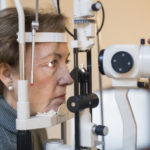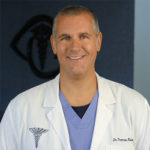By Thomas P. Kislan, OD

Feb. 3, 2021
Glaucoma affects nearly 3 million Americans age 40 and older, with dramatically higher concentrations at age 60 and older.1 The disease’s prevalence means that a significant number of people in every community suffer from glaucoma, which is why we emphasize screening followed by aggressive, consistent long-term management. It also means that glaucoma management is the perfect way to serve patients in your community while expanding your practice with medical visits and advanced diagnostics.
Our glaucoma practice has been growing 20 percent year-over-year for at least the last five years (partly because as I get older so do my patients)! We generate $1 million out of a $5 million practice serving glaucoma patients.
If you’d like to grow your glaucoma services, here are five tips to help you succeed.
Deliver the Latest, Best Care
A strong glaucoma practice offers comprehensive diagnosis, treatment and disease tracking, and links patients to the latest surgical procedures. Over time, patients in your community will learn that your practice offers the latest, best care.
Depending on individual needs, we track for progression using advanced diagnostics such as visual field testing, OCT, optic nerve photography, electroretinography (ERG) and visual evoked potential (VEP) and corneal pachymetry. We recommend the best medication for each patient. If a patient has preexisting ocular surface disease, we can bring that under control with medications such as such as Cequa (Sun Pharma), Restasis (Allergan) or Xiidra (Novartis), and possibly perform LipiFlow (Johnson & Johnson Vision) or Optima IPL (Lumenis).
We also should know all the latest surgical options, connect patients to surgeons and co-manage surgery. We work with surgeons on each patient to coordinate post-op and follow-up care. Surgeons come into our office on certain days to perform Selective Laser Trabeculoplasty (SLT) or do initial surgical consultations, and our patients love that they don’t have to go to another office.
Engage Patients Long Term
Most patients are diagnosed with glaucoma between ages 55 and 65, so we hope to manage their glaucoma for three decades. That’s a new kind of commitment for most patients—one we encourage through early discussions and sharing test results.
“Glaucoma isn’t like diabetes or arthritis,” I explain to patients. “You won’t feel any pain or discomfort, but it’s certainly there. In fact, glaucoma is known as ‘the thief in the night’ because it can worsen and take your vision without you suspecting it. So, it’s important that we work as a team to manage your glaucoma and you keep coming in as scheduled.”
Depending on the severity of the disease, we meet with the patient 2-4 times annually. It’s important to stress upfront that these visits are part of the patient’s medical insurance, just like any doctor’s visit, because they’ve usually only used vision insurance with us in the past.
Editors’ Note: Click HERE to review the AOA’s Clinical Practice Guidelines on glaucoma for guidance on how frequently to see patients diagnosed with the disease.
When I perform testing at each visit, I encourage engagement by sharing results and comparing them over time. For example, because we discuss the goals of therapy, patients know that our goal might be to get their intraocular pressure (IOP) below 20, lower it 30 percent or make sure it doesn’t change. They follow their number every time. I also show patients the results of their visual field test or OCT to help them understand how I’m checking for progression, so we can act quickly on any change.
Keep Everyone on Track
When we track cancellations and no-shows, we’ve found that our patients keep their appointments over 90 percent of the time—a number that’s even higher among glaucoma patients. To both minimize missed visits and make up for no-shows, it’s important to have a robust system in place.
First, we pre-appoint all routine visits, so scheduling is not the patient’s responsibility. When patients either cancel or don’t show up, our staff calls them and stresses the importance of rescheduling the visit because they need their pressure check and other testing to monitor progression. We’ve educated our staff so they can discuss these things knowledgeably. If we can’t get in touch by phone, e-mail or text, we send a certified letter. If a patient is unable to get to the office, we will do a home visit. We also do in-room visits for patients in nursing homes to ensure they get the care they need.
Set Patients Up for Successful Medication Use
The most common first-line treatment is medication. In addition to meeting goals for IOP reduction, we also want to get patients off to a positive start, so they don’t feel discouraged. The best ways to do this are to recommend branded glaucoma medications, not generics, and ensure that patients can comfortably pay for them.
Other Articles to Explore
With branded medications, we know what we’re getting in terms of active ingredients, vehicle and preservatives. In contrast, with a generic drug, we don’t know the binders or fillers, the preservative or the preservative’s concentration—all of which can affect absorption and thus efficacy. Preservatives can cause corneal toxicity, which can affect patients’ compliance. In addition, most generic drugs are manufactured by many different companies, so a patient might receive a 90-day supply of one generic, and then get a different manufacturer’s version the next time. That kind of unpredictability isn’t best for treating glaucoma, and it damages the long-term routine we want patients to establish.
For example, one problematic generic is brimonidine. The generic contains 0.2 percent of the active ingredient, whereas the branded drug (Alphagan P, Allergan) contains 0.1 percent and has the same efficacy. With the generic, patients get double the dose and higher incidence of side effects. We’ve seen a lot of patients with toxicity related to this generic in our local nursing homes and assisted living facilities. I also ran into toxicity problems all the time with generic Cosopt (Merck), which has caused corneal toxicity, burning and stinging for my patients. I’ve recommended branded Cosopt or, given dorzolamide’s sometimes erratic availability, branded Combigan (Allergan).
About 80 percent of our patients use branded medications, but I know some practices in which 80 percent of patients are prescribed generics, and the doctors tell me it’s a matter of money. There is a big misconception among both doctors and patients that branded medications are more expensive. Many commonly used medications, such as Lumigan (Allergan), that have been around a long time are usually covered by insurance.
It comes down to what the doctor thinks is best for patients. I tell my patients, “This medication is going to work better and have fewer side effects. You’ll know what you’re getting every time. It might be $5 extra a month, but it’s really worth it.” Even deductibles are not a major barrier because most patients are on other medications that enable them to meet their deductible anyway. For patients on commercial insurance, manufacturers’ coupons are great, and patients appreciate them. It’s rare to encounter a situation where the branded option can’t be made affordable.
Educate the Community
Outreach is important. We have a monthly television show on our local TV station, Eyecare Today, in which we talk about glaucoma, macular degeneration, new technologies and other topics. We do outreach and education in the newspaper and on Facebook, as well. We’re happy to talk at nursing homes and assisted living facilities. It’s so important to make sure that everyone is getting the care they need to maintain their vision and their health, and the visibility helps build the practice’s reputation as the community’s source for comprehensive eyecare.
Reference
1. Gupta P, Zhao D, Guallar E, Ko F, Boland MV, Friedman DS. Prevalence of Glaucoma in the United States: The 2005–2008 National Health and Nutrition Examination Survey. Invest Ophthalmol Vis Sci. 2016 May; 57(6): 2577–2585.
 Thomas P. Kislan, OD, is the founder and medical director of Stroudsburg Eye Specialists, Hazleton Eye Specialists, Pottsville Eye Specialists and the Dry Eye Center of Northeastern PA, all located in Pennsylvania. To contact him: foreeyes@ptd.net
Thomas P. Kislan, OD, is the founder and medical director of Stroudsburg Eye Specialists, Hazleton Eye Specialists, Pottsville Eye Specialists and the Dry Eye Center of Northeastern PA, all located in Pennsylvania. To contact him: foreeyes@ptd.net





















